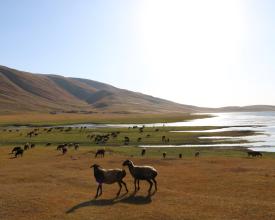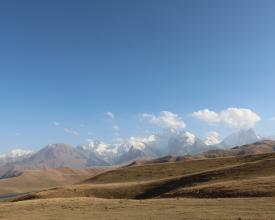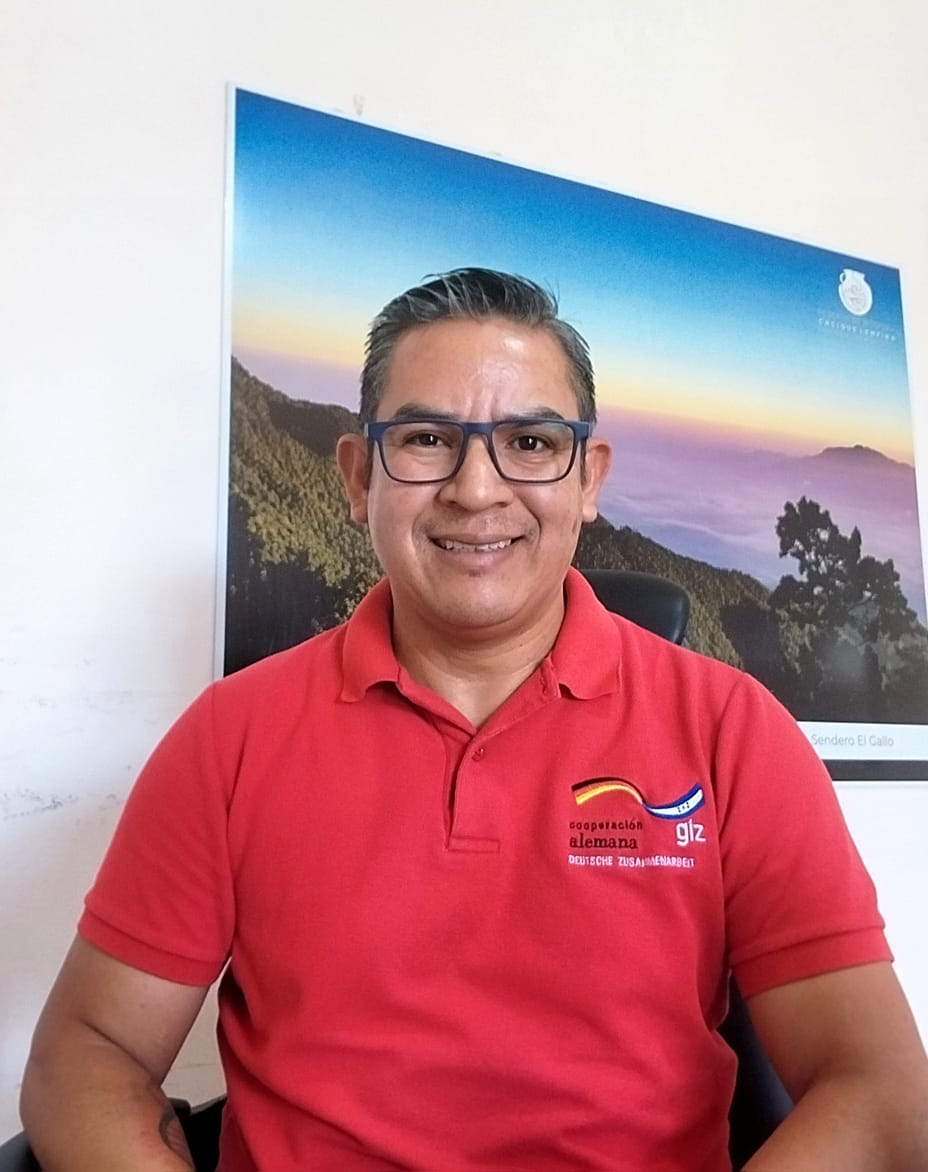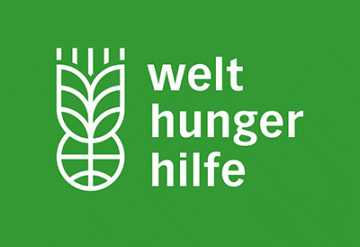
Gestión sostenible de los pastos para mejorar los ecosistemas de pastizales y los medios de subsistencia de los pastores
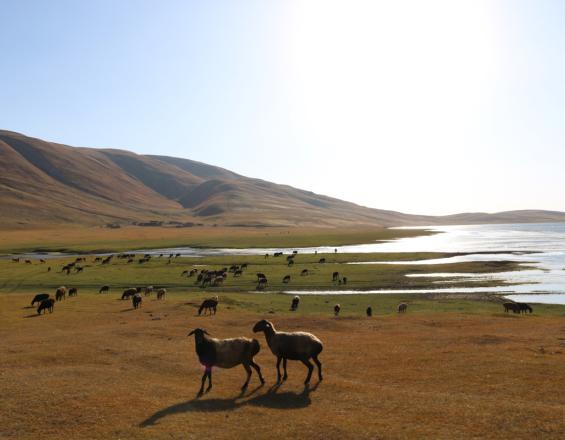
La República de Tayikistán es el país sin salida al mar más pequeño de Asia Central. Con una superficie total de pastos de 3,9 millones de hectáreas, los ecosistemas alpinos constituyen el 80% de las tierras agrícolas del país, que se utilizan en gran medida para la cría de ganado. Los pastos desempeñan un papel fundamental en el desarrollo económico y la reducción de la pobreza en las zonas rurales de Tayikistán. Sin embargo, la degradación de los pastos supone una amenaza cada vez mayor para los medios de subsistencia rurales. La mayor parte del ganado es de propiedad privada, mientras que aproximadamente el 96% de los productos, incluidos los lácteos, son producidos por ganaderos privados. Sólo unas pocas explotaciones utilizan tecnología moderna.
Debido a la degradación de la tierra y al sobrepastoreo, la superficie de pastos ha disminuido desde la independencia. Sin embargo, el número de cabezas de ganado ha aumentado más de un 65% y, en consecuencia, es el principal motor del sobrepastoreo. Esta tendencia amenaza también la importante biodiversidad de los ecosistemas adyacentes, cuya restauración es casi imposible y cada vez más cara.
Contexto
Défis à relever
Tayikistán se enfrenta a un grave problema de presión insostenible sobre los pastos debido al elevado número de cabezas de ganado y a una gestión insuficiente de los pastos. El país necesita urgentemente una mejor gobernanza de los pastos basada en una sólida base jurídica.
El pastoreo excesivo, especialmente en las inmediaciones de las aldeas, ejerce una gran presión sobre los pastos comunales y provoca una grave degradación de la tierra. Esta degradación de la tierra pone en peligro los medios de subsistencia y la seguridad alimentaria de la población rural tayika.
seguridad alimentaria de la población rural tayika. A pesar de la aprobación de la ley de pastos en 2019, los mecanismos comunitarios de pastoreo controlado aún no están generalizados. Las principales razones son la ausencia de ordenanzas y la débil aplicación de la ley. La planificación de la gestión sostenible de los pastos es, por tanto, una herramienta crucial que deben aplicar los usuarios de los pastos.
Ubicación
Procesar
Resumen del proceso
Para que la gestión sostenible de los pastos tenga éxito, es necesario abordar y mejorar tanto la gobernanza de los pastos como las técnicas de gestión de los mismos. Un marco jurídico sólido y el desarrollo organizativo proporcionan la estructura necesaria para mantener el número de cabezas de ganado en un nivel sostenible. Las técnicas de gestión de pastos, incluso las más básicas, como la introducción de un plan de gestión de pastos y calendarios de pastoreo, pueden contribuir a un uso óptimo de los pastos, aunque sostenible.
Bloques de construcción
Gobernanza de los pastos
Mejora del marco jurídico
Tayikistán se enfrenta a un grave problema de presión insostenible del pastoreo debido al elevado número de cabezas de ganado y a la insuficiente gestión de los pastos. El país necesita urgentemente una mejor gobernanza de los pastos basada en una base jurídica sólida. Por ello, la GIZ Tayikistán ha trabajado en la mejora del marco legal y ha facilitado el diálogo entre las diferentes partes interesadas.
Además, junto con otras organizaciones, se ha llevado a caboun análisis institucional sobre la gestión de los pastos en Tayikistán que describe la estructura institucional y jurídica y la distribución de funciones y responsabilidades en el sector de la gestión de los pastos en Tayikistán para apoyar el proceso de gobernanza en el futuro.
El objetivo de la PMNP es contribuir a la gestión sostenible de los pastos en Tayikistán. El objetivo se persigue a través del diálogo nacional y el intercambio de conocimientos basados en experiencias prácticas y sobre el terreno de los miembros de la red de gestión de pastos.
Factores facilitadores
1. Realizar un análisis institucional sobre la gestión de los pastos en Tayikistán
2. Apoyar una ley sólida sobre pastos y ordenanzas viables
3. Apoyar la creación de uniones de usuarios de pastos (PUU)*.
*Las Uniones de Usuarios de Pastos (PUU) están formadas por usuarios de pastos y se establecen a nivel de jamoat (municipio rural) con miembros de varios pueblos. Se trata de una organización formal, dotada de estatutos y registro legal, sello y cuenta bancaria.
Lección aprendida
A la hora de mejorar la gobernanza de los pastos debería tenerse en cuenta lo siguiente
- Informar a todas las partes interesadas sobre la ley de pastos y apoyar el cumplimiento de las ordenanzas;
- Especificar las funciones y responsabilidades en la gestión de los pastos y asegurarse de que todas las partes interesadas son conscientes de sus funciones y responsabilidades;
- Identificar los puntos de entrada para la futura mejora del marco jurídico;
- Garantizar una buena coordinación de los donantes;
- Apoyar la creación de Uniones de Usuarios de Pastos (PUU) y de la Comisión de Pastos (CoP);
- Fomentar la transferencia de conocimientos sobre buenas prácticas.
Recursos
Técnicas de gestión de pastos
Planificación de la gestión de los pastos en Tayikistán
El pastoreo excesivo, especialmente en las inmediaciones de las aldeas, ejerce una gran presión sobre los pastos comunales y provoca una grave degradación de la tierra. Esta degradación de la tierra pone en peligro los medios de vida y la seguridad alimentaria de la población rural tayika. A pesar de la aprobación de la ley de pastos en 2013 (que establece el marco), los mecanismos comunitarios de pastoreo controlado aún no están generalizados. Las principales razones son la ausencia de reglamentos y la escasa aplicación de la ley. La planificación de la gestión sostenible de los pastos es, por tanto, una herramienta crucial que deben aplicar los usuarios de los pastos.
Factores facilitadores
1. Estudio de los planes actuales de gestión de pastos para identificar las necesidades de mejora
2. Catálogo de especies vegetales de los pastos
3. Herramienta de cálculo de la capacidad de carga de los pastos
4. Calendarios de pastoreo
5. Técnicas de producción sostenible de forraje para la temporada de invierno
Lección aprendida
Para aplicar con éxito las técnicas de gestión sostenible de los pastos, hay que tener en cuenta lo siguiente:
- Evaluar las condiciones actuales de los pastos y examinar la forma en que la comunidad gestiona sus pastos;
- Mejorar la gestión del ganado en general y no fijarse sólo en la gestión de los pastos;
- Aplicar una herramienta sencilla para calcular la capacidad de carga de los pastos;
- Proporcionar ejercicios prácticos sobre el terreno a los ganaderos, por ejemplo, mediante escuelas de campo para ganaderos;
- Garantizar que los pastos puedan regenerarse tras un periodo de pastoreo y que los pastos no se pasten demasiado pronto en primavera;
- Proporcionar técnicas de vallado de bajo coste;
-
Utilizar variedades tradicionales y locales de semillas forrajeras;
-
Aumentar la diversidad de plantas que proporcionen néctar a los polinizadores e insectos beneficiosos;
-
Controlar y prevenir la erosión;
-
Garantizar beneficios económicos a los agricultores
-
Garantizar el uso óptimo de las zonas de producción de forraje;
-
Garantizar el acceso a las tecnologías mediante la documentación de técnicas en plataformas como Wocat y PANORAMA.
Impactos
Para que la gestión de los pastos sea sostenible en Asia Central, deben abordarse por igual las siguientes dimensiones:
- Instituciones: Sobre la base de un diálogo entre múltiples partes interesadas, se mejoró el marco jurídico de la gestión de los pastos y se elaboraron reglamentos para garantizar su aplicación.
- Desarrollo organizativo: Se crearon uniones de usuarios de pastos (PUU) en todas las regiones y se fundó una plataforma nacional de redes de gestión de pastos que garantiza el intercambio entre todos los pastores y facilita el diálogo con los responsables políticos.
- Desarrollo de competencias: Los eventos de formación sobre planificación de la gestión de pastos para pastores permiten a los usuarios de pastos planificar y gestionar sus tierras de forma sostenible.
- Gestión del conocimiento: Se creó un sistema de gestión de documentos en línea que permite el acceso instantáneo a diversas técnicas de gestión de pastos y documentos de planificación.
- Relaciones socioculturales: Las tradiciones y culturas locales se reflejan en los planes de gestión de los pastos.
- Planificación y seguimiento: Los planes sencillos de gestión de los pastos y los calendarios de pastoreo permiten a los pastores planificar la gestión sostenible de su ecosistema conjuntamente con otros usuarios de los pastos.
- Medio ambiente: Se recomienda plantar semillas de pastos locales y diversificar las especies de pastos en la medida de lo posible. Esto garantizará un rebrote óptimo y néctar para los insectos beneficiosos y permitirá la producción de miel como negocio secundario.
Beneficiarios
Los beneficiarios son pastores de todas las regiones de Tayikistán. Además, el enfoque respalda la gobernanza de los pastos y, por tanto, apoya al Fondo de Pastos del Ministerio de Agricultura de la República de Tayikistán.
Objetivos de Desarrollo Sostenible
Historia
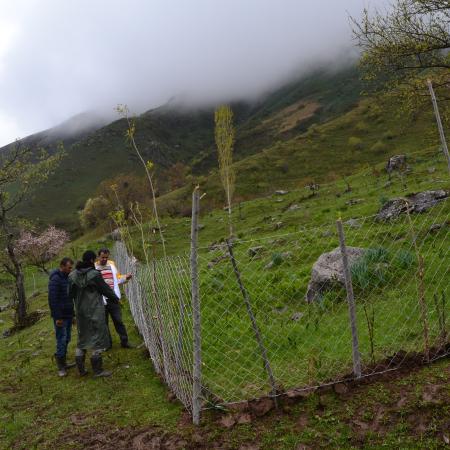
Saidashraf Iskandarov cultiva una parcela de aproximadamente una hectárea en las colinas de la cuenca hidrográfica de Jafr, en el verde valle de Rasht, en Tayikistán. Gracias al proyecto, ha empezado a cultivar forraje en su parcela, que antes utilizaba para algunas especies de árboles frutales y para el pastoreo de su rebaño de ovejas y cabras. El proyecto le ha ayudado a vallar parcialmente la zona y a instalar curvas de nivel en su parcela para mejorar la retención del agua.
El forraje que cosecha en la parcela proporciona alimento suficiente para su ganado durante los largos y fríos meses de invierno. Los excedentes los vende en el mercado a precios relativamente altos, ya que el forraje escasea y los precios aumentan exponencialmente en invierno.
Durante el año y medio transcurrido desde que cercó la zona y dejó de pastar en las proximidades de los árboles, también ha podido cosechar más frutos y los árboles han crecido más rápido sin la perturbación de los animales.
Además, el Sr. Iskandarov ha instalado cuatro colmenas en su parcela, de las que produce miel para su consumo y el de su familia.

